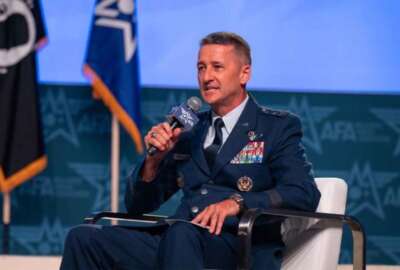Hubbard Radio Washington DC, LLC. All rights reserved. This website is not intended for users located within the European Economic Area.
DoD gets partner from academia to help tackle complex problems
The University of South Florida (USF) recently opened a new lab aimed at providing quick innovative solutions to the different challenges facing the Department.
The University of South Florida (USF) recently opened a new lab aimed at providing quick, innovative solutions to the different challenges facing the Department of Defense. The new Rapid Experimentation Lab (REL) hopes to provide a unique, collaborative space to rapidly test concepts. To learn more, Federal News Network’s Eric White spoke with Taylor Johnston on The Federal Drive with Tom Temin , COO of USF’s Institute of Applied Engineering, which is managing the lab.
Interview Transcript:
Eric White Absolutely. So why don’t we start from the beginning? How did this all come together? How did you find yourself in business with the Department of Defense? Trying to solve some of their always complex problems.
Taylor Johnston Thanks for the question. I am actually a 21 year Air Force veteran, so I’m a buyer by trade. I flew the C-21 C-130 and KC-135 in the Air Force. And while I was in the Air Force, I got to community and help a unit called Contingency Response Units. Contingency response units are challenged with setting up an air base anywhere in the world at a moment’s notice. And this is back in the mid to 2015-2016 timeframe, where essentially the problems we got were, hey, you’ve got two planes coming tonight. Figure what you can put on board and go. At that time we were dealing with antiquated generators and some other old equipment where that really got my innovation green and innovation meter ideas going, and we started looking at new ways to do power generation, new ways to use communications. And this is also at the start of AFWERX and some of the DIUs at the Defense Innovation Unit. And I got to be at the ground floor of that as an active duty member. Following my tours and the contingency response units, I ended up as the Director of Innovation for the six day Refueling Wing, which is MacDill Air Force Base. After retirement, one of the universities that I dealt with at the time was the University of South Florida. Now, the University of South Florida has this interesting arm that is a 500 1C3 nonprofit that connects those academics to federal money via contracts basis. So that’s kind of how I got involved in it. And what we do for the DoD writ large is try to solve and bring those academics to solve those tough problems for the DoD. So it’s not from a business where a 501c3 attached to the university. It’s more providing that PhD lift of talent to the top problems of the DoD.
Eric White So before we get into the lab itself, we say complex problems. Why don’t we put a label on that? What kind of problems are you looking towards. And obviously they’re complex. So don’t feel the need to get too into the nitty gritty. But overall, what are you all going to be looking at?
Taylor Johnston Well, the Institute of Applied Engineering started in 2019 as a primarily an engineering solutions program to solve everything from a rapid mechanical design problem or some software solutions for some unattended ground sensors. What we figured out over the course of the last five years is you don’t just need that unattended ground sensor that talks to the tech network, that talks across the spectrum. You need a holistic approach to some of these new designs and new solutions. Because if I’m building anything on a mechanical thing, it’s obviously going to have some sort of electrical component, which is going to involve a chip. Where does that chip come from? How do I look at this from a business case example to an engineering solution? And then what are the policy implications of that incident solution. So we’re able to bridge the entire university to come to a solution for the DoD that actually is able to attack those wicked problems.
Eric White Gotcha. All right. So let’s get into the facility itself. You had mentioned some experience that you had with AFWERX and DIU. What lessons did you take from those agencies when modeling this lab? Did you take anything of, Oh, they do it real well over there. Let’s make sure to implement it here.
Taylor Johnston Well, one of the things that I noticed both from AFWERX, and the beautiful thing about AFWERX is there’s no real innovation, what we call Air Force specialty code. They take an airman that could be a maintainer, could be a medic, could be a troop, could be a flier like myself. And they bring them into a room with a whole bunch of different experiences. Let them ideate, let them try to solve the problem and think about different solutions, because those different perspectives usually bring about a better solution than a stovepipe kind of answer, solely by the troops or solely by the maintainers. That’s what we try to do at the lab is create a space where I have mechanical engineers, electrical engineers, RF engineers, physicists, medical folks all in the same room, and all with that collaboration space that they’re able to go from the whiteboard to a 3D printer to a welder, to an RF chamber, an anechoic chamber, and able to bring an idea to a solution, interdisciplinary wise.
Eric White We’re speaking with Taylor Johnston. He’s the chief operating officer of the Institute of Applied Engineering at the University of South Florida. So an 8,000 square foot facility is what you have, and you want to let your engineers cook in there. What sorts of new tools and innovative technologies are you bringing in there to make sure that these engineers, they’re not going to be there forever, obviously, and they’re in high demand, I’m sure once they graduate, what do they get out of this?
Taylor Johnston Well, we do have everything from our student interns to graduate assistants to professional staff. So I have 21 engineers on my staff that are permanent members of the institute, and we’re able to actually bring in university professors to the lab. The beautiful thing about the lab is that there are seven different types of additive manufacturing machines. There’s also soldering and welding equipment in there. There’s also printed circuit machines in there, sort of print circuit boards. And there’s also RF and anechoic chambers in there too, and also everything from drill presses to laser engravers to CNC machines. Basically, everything you need to make a product that we all know is not just fabricating a product that is also incorporated in electronics in the product.
Eric White Yeah. And I want to go back to this concept of you just kind of letting the engineers do their thing. What space do they have to also conduct some experiments where it may not all work out, but tinkering is how a lot of things are discovered. What can you tell me about that aspect of things?
Taylor Johnston I’ll go back to a little bit of the fact that we are primarily a task driven organization. So the DoD comes to us with that, Hey, I need a solution to this. And we’ll go out and either do an analysis of alternatives, or we’ll go out and try and prove what they’re trying to do and actually build what they want to have built. Part of that also, as you intimated towards, allows our engineers to figure out things that they may or may not be useful in applications towards the DoD, but they are something like using the iridium satellite network for communications versus the new Starlink. What’s capable of this? Some of the things that are out there that may or may not be useful today. And how are we able to parse things and do edge computing for things that may or may not be done on the cloud? So a lot of the things today are cloud computing and cloud infrastructure. But when you start to talk about the Department of Defense’s needs for able to be computed on edge on device in a remote environment, you start to see some different types of problems there than usual businesses face.
Eric White What can you tell me about where this facility stands as far as setting apart other opportunities at other universities? Is this a unique opportunity for University of South Florida students, or are there facilities like this at other universities, and if so, what makes this one different from those?
Taylor Johnston There are seeing these around the nation. There are 13, I believe, university affiliated research center. So those are dedicated sponsored activities from the DoD at specific universities around the nation. The University of South Florida is more of a startup in an established ecosystem. So there’s the behemoths out there, like Johns Hopkins Applied Physics Lab and Georgia Tech Research Institute. We do a lot of research for the DoD. Those are both. The University of South Florida is well positioned just because of its geographical location, next to two combatant commands, which know where the university can really offer next to CENTCOM and SOCOM, and able to be basically a young, scrappy startup that’s able to do things a little bit outside of the box, that these older institutions may or may not have the capacity to do.
Eric White And of course, the weather’s not too bad.
Taylor Johnston The weather is absolutely perfect. Today it’s about 76 degrees and I do not see a cloud the day.
Eric White Can’t beat that. All right. Anything else that we didn’t touch on that you think is important for the conversation?
Taylor Johnston One of the important things here to note, when you think of universities, you usually think of what we call 6.1 or 6.2 basic and fundamental research dollars. It’s usually grant based. The institute is primarily designed around doing things these contract based and federal acquisition regulations and agreements with researchers, which is rare, and the ability to do things at both the controlled, unclassified level and also up to the top secret, secure compartmentalized information level so it allow researchers to do things on contract, which means that you actually do get something at the end, on time and on the schedule, versus a researcher doing things that a researcher may or may not want to do, that may or may not have applicability with the DoD. You get something that’s on time, on schedule, and it is able to be at the classification of the customer.
Copyright © 2024 Federal News Network. All rights reserved. This website is not intended for users located within the European Economic Area.
Eric White
Eric White is news anchor and Federal Drive producer at Federal News Network.
Follow @FEDERALNEWSCAST
Related Stories
On DoD

WEDNESDAYS, 11 A.M. & 2 P.M.
Each week, Defense Reporter Jared Serbu speaks with the managers of the federal government's largest department. Subscribe on PodcastOne or Apple Podcasts.





